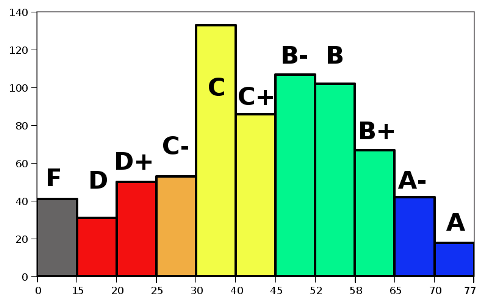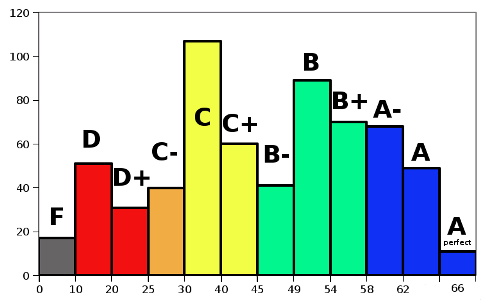First Midterm: 8:30 pm on Wednesday, October 15, 2008
The exam will be in various locations around the campus. Where you should go depends on which recitation you are enrolled in.Bring a photo ID. No calculators will be allowed.
The midterm covers sections 1.1 through 1.6, Appendix C, and sections
2.1 through 3.1 of the text.
Doing all of the homework problems
prior to the exam is a very good idea. Doing additional problems
from the text can be helpful.
You should be able to do all the problems on these practice exams from previous semesters. However, keep in mind that our exam is later in the semester than in previous years, so these don't cover derivatives. Ours will.
The solutions are also available, but please work the problems out for
yourself before looking at them, or you won't learn anything. Here are the
solutions to the Spring 06 practice, the
Solutions to Spring 07 exam, and the
Solutions to the derivative-related problems.
Results: While there were a couple of tricky problems on the exam, the majority of the problems were quite standard, and similar both to the homework and the sample exams. Nevertheless, many people did terribly. Below is a graph of the score distribution on the exam.

|
|
You can check your grade here. If you got less than 30 on the exam, you should seriously consider moving down to MAT123, which can be done with this form.
There were two different versions of the exam. Here is Version A, and the Solutions to version A. You might prefer Version B and the Solutions to version B. They are pretty similar, though.
Second Midterm: 8:30 pm on Monday, November 17, 2008
The second midterm will cover the material we have covered since the first exam: sections 3.1 through 4.2.
PLEASE BRING A PEN, as well as a photo ID. There was some issue with erasures and regrading on the first exam, so if you want to be able to contest the grading of a problem, it must be written in pen, not pencil.
Here are some sample problems you can work on to help yourself prepare. Here are the solutions, but of course you should work the problems yourself before looking at these. (There were two typos in solutions to problems 1b and 8c. These are fixed as of Nov 16, 9:10pm).
Results: In general, people did quite well on this exam. It was probably a little too easy, since there were quite a few (at least 11) people who got no points taken off. Despite the fact that the exam was not hard, there were quite a few people with rather low scores; these people will need to make some significant changes if they expect to pass the course.
Below is a graph of the score distribution on the exam.

|
|
You can check your grade here. If you got less than 30 on the exam, you are in serious danger of not passing the course.
There were three rather similar versions of the exam: Version 1 (solution), Version 2 (solution), and Version 3 (solution).
Final Exam: 2 pm on Thursday, December 18, 2008
The final will be cumulative, covering everything that we have done in the class. However, extra emphasis will be on material since the second midterm (chapter 4).
Note that you will be taking the final in a different place from where you took the exams.
| Section | TA | Location |
|---|---|---|
| R05, R06 | Stas Ostrovsky | Humanities 1003 |
| R07, R91 | Lauren Pross, Paul Cernea | Humanities 1006 |
| R12, R15 | Ritwik Mukherjee | Javits 109 |
| R30, R36 | Matthew Wroten | Javits 111 |
| R01, R02, R03, R04, R08, R10, R11, R12, R13, R14, R15, R16, R17, R20, R21, R22, R23, R24, R25, R26, R31, R32, R33, R34, R35 | everybody else | Sports Arena (near the union) |
It is much more important that you know understand how to do calculus than memorize a bunch of formulae. So, I will let you bring a single sheet of notes with you to the exam. This note sheet must be handwritten, not a xerox or a printout. It can be written only on one side of the page, the page can be no larger than a standard sheet of letter paper (8.5" by 11"), and the sheet must be turned in along with your exam. Students using notes which don't fit this guideline will be charged with academic dishonesty. Note that you can write whatever you think will be helpful on your notes: formulae, examples, or the lyrics to your favorite song.
In order to study, you should do lots of problems. While doing the Extra Credit assignment on WebAssign will help, it isn't sufficient unless you are already well-prepared. Remember that you can also get the solutions to all the old online homeworks in WebAssign.
In addition, here are some practice problems from Fall '06, spring '06, and some review problems I wrote in 2004. Here are the solutions: Fall 06, Spring 06, and 2004 problems. Please work the problems before reading the solutions, or they won't do you any good.
Review Sessions
- Friday Dec 12 during class (9:35-10:30), Old Chem 116 (Scott Sutherland)
- Tuesday Dec 16, 2pm-4pm, Earth&Space 001 (Scott Sutherland)
- Wednesday Dec 17, 10am-12pm, Math P131 (Carlos Martinez)
- Wednesday Dec 17, 5pm, Physics P-117 (Paul Cernea)
- Thursday Dec 18, 11:30am-1pm, Physics P-122 (Paul Cernea)
- Thursday Dec 18, 12:30-1:30pm, Math P131 (Jessica Sherman)